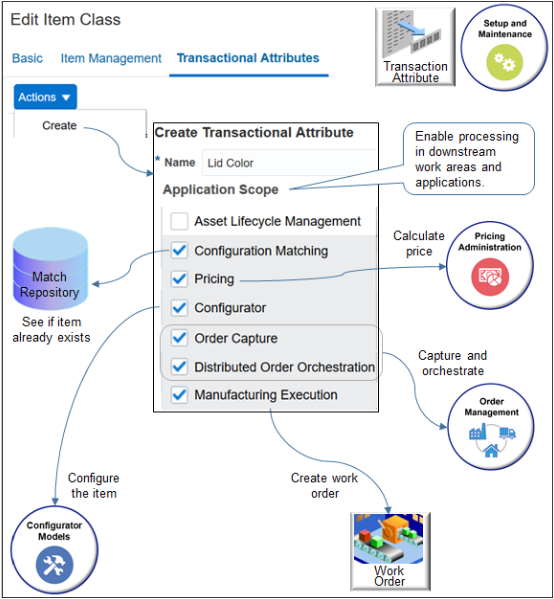Guidelines for Capturing Transaction Details
Create a transaction attribute to capture details in an Oracle Cloud application where the details change for each transaction.
Oracle Order Management uses a sales order to record details about a transaction you make between you and your customer. Use a transaction attribute to capture details that are specific to each sales order transaction. For example, assume the item is Transmission Service, and License Plate Number is the transaction attribute. The license plate number changes for each transmission service transaction, but you can only capture the license plate number at runtime because its specific to each customer. You don't know who the customer is at design time so you can't use an extensible flexfield that references a predefined value set.
You use an item class to organize your transaction attributes. For example, create an item class named Auto Repair Services, then add transaction attribute Transmission Service to it. Add other relevant transaction attributes to the same class. For example, add transaction attribute Transmission Serial Number to capture the serial number of the transmission you repair.
Note
-
Use a transaction attribute to store values that change at runtime.
-
Set the attribute up as part of the item class. A child class can inherit the attribute, so don't place it on the root item class. A root class might inherit values from a wide range of items, but you typically use a transaction attribute for a specific item. You can't delete a transaction attribute if you assign it to a lower class.
-
Supply Chain Orchestration can use a transaction attribute throughout fulfillment, but some fulfillment systems might not support them, such as purchasing or shipping.
-
If your value set uses numeric values, then make sure you include a minimum value and a maximum value on the Manage Value Sets page. If you don't, the Configurator Models work area might display an error when you import the model snapshot.
For details, see Manage Transactional Attributes.
Learn how to add an attribute that allows your user to add details to a sales order while the user creates the sales order. For details, see Overview of Using Extensible Flexfields in Order Management.
Set the Application Scope
Use the Application Scope to choose the applications where you use the transaction attribute.

If you use Oracle Order Management, then you must add a check mark to each of these application scopes. They enable downstream work areas and applications to use your transaction item as part of a configure-to-order flow.
|
Scope |
Description |
|---|---|
|
Configuration Matching |
Enable Supply Chain Orchestration to examine the match repository to see if there's a match. If your flow uses the transaction attribute to create a unique configured item, then you must add a check mark to Configuration Matching. If you do, Supply Chain Orchestration will examine the match repository. If it doesn't find a match, it will create a new configuration for each unique attribute value, then save the configuration. |
|
Pricing |
Use the values you set in the Pricing Administration work area to price the item. |
|
Configurator |
Configure the item at runtime during order capture. |
|
Order Capture |
Capture the sales order that your user creates in the Order Management work area or that you import. |
|
Distributed Order Orchestration |
Use the orchestration part of Oracle Order Management, particularly the orchestration process. |
|
Manufacturing Execution |
Enable manufacturing to add your configured item to the work order. |
Your user must also select an option that your model uses as a transaction attribute when the user configures the assemble-to-order item on the sales order in Order Management.